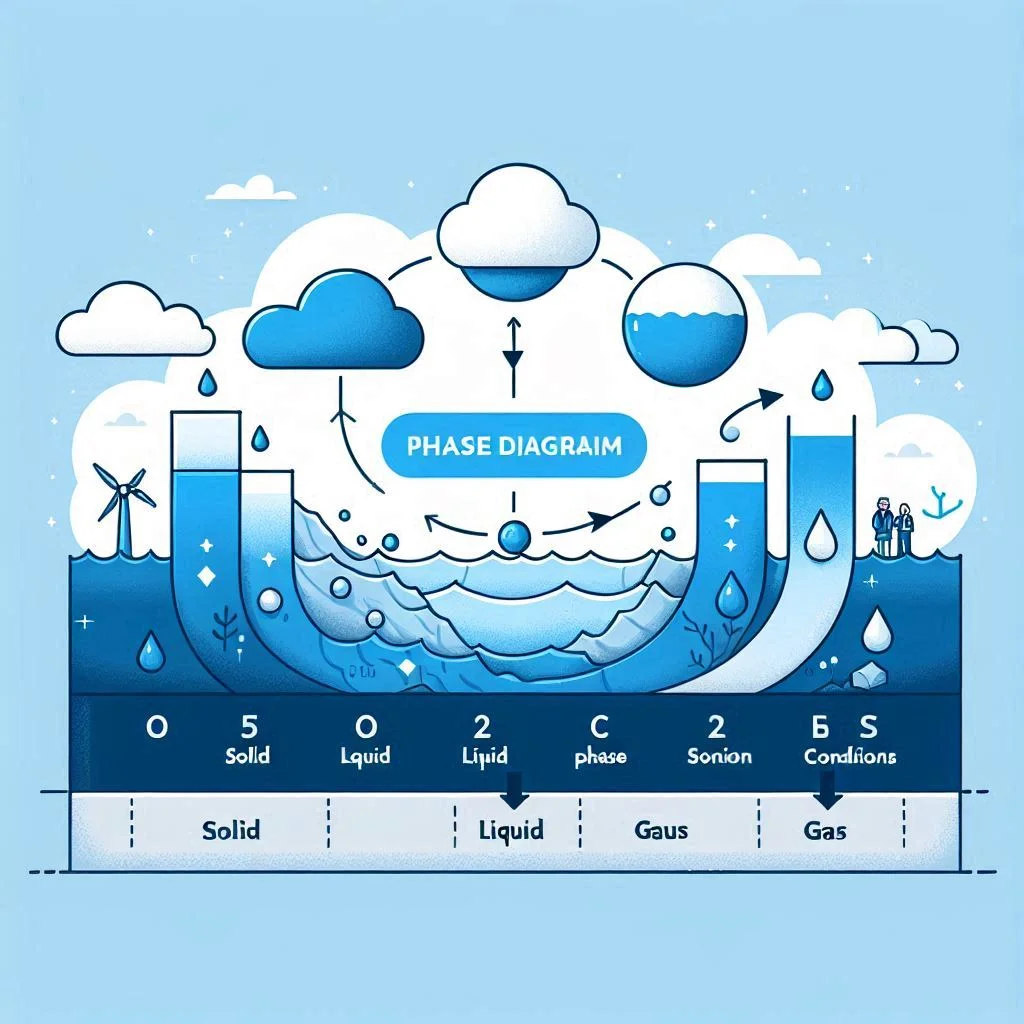Understanding the Triple Point and Its Relation to Sublimation
Find the fascinating science behind the triple point and sublimation. Learn how these phase transitions occur and their practical applications in industries like pharmaceuticals and textiles, and explore real-world examples.
Uncover the secrets of thermodynamic equilibrium and how understanding these concepts can drive innovation and efficiency.
Introduction
Matter, in its various forms, continuously transforms from one state to another, known as phase transitions. These transitions, such as melting, freezing, and evaporation, are fundamental processes observed in everyday life and scientific applications. Among these transitions, the concept of the triple
The point stands out as a unique condition where solid, liquid, and gas phases coexist in perfect equilibrium. Understanding the triple Point deepens our comprehension of phase transitions and reveals intriguing insights into the sublimation process.
The Triple Point is a specific combination of temperature and pressure at which a substance can exist simultaneously in three phases: solid, liquid, and gas. This precise equilibrium is not just a theoretical construct; it has practical implications in fields ranging from material science to meteorology.
For example, the triple point of water, at 0.01°C and 611.657 pascals, defines the Kelvin temperature scale.
Sublimation, the direct transition from solid to gas without passing through the liquid phase, is another fascinating phase transition closely related to the triple Point. It occurs under specific temperature and pressure conditions, often below the triple Point.
Sublimation is a natural curiosity and a critical process in various industries. For instance, freeze-drying—a sublimation-based technique—is employed in the pharmaceutical and food industries to preserve products by removing water content while maintaining structural integrity.
Subli Genius Print offers invaluable problem-solving tips for sublimation works, aiding users in making informed decisions and optimizing their results. By understanding the triple Point and sublimation relationship, users can achieve better precision and efficiency in their sublimation projects.
In this article, we will explore the intricate details of the triple Point, delve into the science behind Sublimation, and examine their interconnection.
We will highlight practical applications and provide educational resources to enhance your understanding of these essential concepts.
What is the Triple Point?
A substance’s triple Point is a unique state where the three phases of matter—solid, liquid, and gas—exist in thermodynamic equilibrium. At this precise combination of temperature and pressure, the substance can transition between these phases without any net change in their amounts. This concept is fundamental to understanding phase transitions and the behavior of different materials under varying environmental conditions.
To grasp the significance of the triple Point, we must delve into thermodynamic equilibrium, a state where the energy and matter in a system are balanced, and no net change occurs over time. At the triple Point, the rates at which the substance transitions between solid, liquid, and gas phases are equal, maintaining this delicate equilibrium.
When discussing heat press temperature for sublimation, guide your readers to additional details:
- For optimal printing, make sure to check the recommended heat press temperature for sublimation.
Examples of Triple Points
Different substances have unique triple points, reflecting their distinct physical properties. For example:
- Water: As mentioned, the triple point of water occurs at 0.01°C and 611.657 pascals. This Point is crucial in defining the Kelvin temperature scale and is a reference for calibrating thermometers.
- Carbon Dioxide: The triple Point of carbon dioxide is at -56.6°C and 5.11 atmospheric pressure. Unlike water, CO₂ is not a liquid at standard atmospheric pressure; it sublimates directly from solid to gas.
- Sulfur: The triple Point of sulfur is at 115.21°C and 5.10 kilopascals. Understanding sulfur’s triple Point is essential in various chemical and industrial processes.
The Triple Point provides a foundational understanding of how substances behave under different conditions. It is a critical reference for scientists and engineers working with materials that undergo phase transitions. As we explore further, we will see how this concept links to Sublimation and its practical applications.
The Science Behind the Triple Point
A substancePointiple point is a fascinating concept that reveals the intricate interplay between temperature, pressure, and phase transitions. Understanding the conditions at the Triple Point requires a deeper dive into the science that governs these phenomena.
Conditions at the Triple Point
The Triple Point is defined by a specific temperature and pressure at which a substance’s solid, liquid, and gas phases coexist in perfect thermodynamic equilibrium. This delicate balance is achieved when the Gibbs free energy of all three phases is identical, allowing them to coexist without net phase transition.
For a substance to reach its triple Point, the following conditions must be met:
- Temperature: The precise temperature at which the substance’s solid, liquid, and gas phases coexist.
- Pressure: The exact pressure that allows these three phases to be in equilibrium.
Thermodynamic Equilibrium
Thermodynamic equilibrium is a state where all macroscopic flows of matter and energy have ceased, and the system’s properties remain unchanging over time. At the triple points, equilibrium is achieved because the transition rates between the solid, liquid, and gas phases are equal, resulting in a stable coexistence of all three phases.

Examples of Substances and Their Triple Points
Different substances have unique triple points determined by their molecular structure and intermolecular forces. Here are a few notable examples:
- Water (H₂O): Water’s triple points are 0.01°C and 611.657 pascals. This Point is significant in defining the Kelvin temperature scale and is used as a reference for high-precision thermometers.
- Carbon Dioxide (CO₂): The triple Point of carbPointoxide is at -56.6°C and 5.11 atmospheres. At this point, CO₂ simultaneously st as dry ice, liquid CO₂, and gaseous CO₂. Notably, CO₂ sublimates directly from solid to gas at standard atmospheric pressure without becoming a liquid.
- Sulfur (S): Sulfur’s triple Point is at 1Point°C and 5.10 kilopascals. This information is crucial for industrial processes involving sulfur, such as the production of sulfuric acid.
Detailed Explanation of the Science
At the triple Point, the GiPointree energy, which combines enthalpy and entropy, is minimized for all three phases. This results in no net change as the substance transitions between phases, creating a dynamic equilibrium. The balance of molecular interactions and energy states at this precise temperature and pressure allows the substance to remain stable in all three phases.
Understanding the triple Point is essential for numerous scientific and industrial applications. For example, precise control of temperature and pressure conditions in cryogenics, material science, and chemical engineering relies on knowledge of various substances’ triple points.
When introducing the opposite of sublimation, link to more in-depth content: Learn more about this reverse process in our article on the opposite of sublimation.
Understanding Sublimation
Sublimation is a fascinating phase transition where a substance changes directly from a solid to a gas without passing through the liquid phase. This phenomenon occurs under specific temperature and pressure conditions, often below the triple Point. UndersPointng sublimation provides insight into various natural and industrial processes.
Definition of Sublimation
Sublimation is when a solid transforms directly into a gas, bypassing the liquid state. This phase transition occurs when the molecules in the solid phase gain enough energy to break free from their fixed positions and enter the gas phase. For Sublimation to occur, the ambient pressure must be lower than the substance’s triple point pressure, and the temperature must be sufficient to provide the necessary energy for the phase change.
Conditions Under Which Sublimation Occurs
Sublimation typically occurs under low-pressure conditions and at temperatures where the substance’s solid phase can gain enough kinetic energy to transition directly into the gas phase. The conditions required for Sublimation can be understood by examining the substance’s phase diagram, particularly the regions below the triple Point.
For export:
- Carbon Dioxide (CO₂): Solid carbon dioxide (dry ice) sublimates at -78.5°C at standard atmospheric pressure, transforming directly into carbon dioxide gas.
- Iodine (I₂): Iodine sublimates at room temperature, slowly transitioning from a solid to a violet gas without becoming a liquid.
Comparison with Other Phase Transitions
To fully appreciate Sublimation, it’s helpful to compare it with other typical phase transitions:
- Melting: The transition from solid to liquid when a substance gains enough energy to overcome the forces holding its molecules in a fixed position.
- Freezing: The reverse of melting, where a liquid becomes a solid as it loses energy, and its molecules settle into a fixed structure.
- Evaporation: The transition from liquid to gas at the surface of a liquid when molecules gain enough energy to escape into the vapor phase.
- Condensation: The reverse of evaporation, where gas molecules lose energy and transition into the liquid phase.
Practical Examples of Sublimation
- Dry Ice (CO₂): Used in refrigeration and theatrical effects, dry ice sublimates at -78.5°C, producing a dense, white fog.
- Iodine (I₂): When heated, iodine crystals sublimate to form a violet gas, which is used in various chemical processes and laboratory demonstrations.
- Naphthalene: Commonly found in mothballs, naphthalene sublimates at room temperature, releasing vapors that act as a pest deterrent.
Sublimation in Everyday Life
Sublimation is not just a scientific curiosity; it has practical applications in daily life and industry. For example:
- Freeze-Drying: A process used in pharmaceuticals and food preservation where water is removed from a frozen product by Sublimation, preserving its structure and nutritional content.
- Frost-Free Freezers: These appliances use Sublimation to remove ice buildup without manual defrosting.
Benefits of Sublimation
Sublimation offers several benefits in industrial and scientific applications:
- Preservation: Freeze-drying extends the shelf life of perishable goods without compromising quality.
- Efficiency: Sublimation-based processes are often more efficient and require less energy than those involving liquid phases.
- Purity: Sublimation can purify substances, as impurities typically do not sublimate with the solid.
For pricing-related queries, offer tools and calculators: Calculate your costs effectively with our sublimation pricing calculator.
The Relationship Between the Triple Point and Sublimation
The Triple Point and subpoint are intricately connected concepts in the study of phase transitions. Understanding how the triple Point influences pointublimation helps us appreciate the unique conditions under which these phenomena occur and their significance in various applications.
How the Triple Point Influences Sublimation
The triple Point represents the unique conditions under which a substance’s solid, liquid, and gas phases coexist in equilibrium. Below the triple point pressure, a substance cannot exist in the liquid phase; it can only transition directly between the solid and gas phases. This is where Sublimation comes into play.
Increasing temperature at pressures below the principal Point leads a solid to gain sufficient energy to bypass the liquid phase and transition directly into a gas. Thus, the triple point delineation points boundaries of phase transitions, including Sublimation, dictating the conditions under which these transitions can occur.
Phase Boundaries and Their Significance
Phase diagrams map out the conditions under which different phases of a substance exist. These diagrams have lines, or boundaries, that separate different phases:
- Melting/Freezing Line: Separates the solid and liquid phases.
- Sublimation/Deposition Line: Separates the solid and gas phases.
- Evaporation/Condensation Line: Separates the liquid and gas phases.
The Triple Point is where the Pointe lines converge. Below the triple point pressure, the sublimation/deposition line becomes critical because it is the only pathway for phase transitions between solid and gas. This boundary helps us understand and predict the behavior of substances under various environmental conditions.
Examples of Sublimation Influenced by the Triple Point
Dry Ice (CO₂)
- Triple Point: -56.6°CPoint5.11 atmospheres.
- Sublimation: At standard atmospheric pressure (1 atmosphere), dry ice sublimates directly from solid to gas at -78.5°C because it cannot exist as a liquid under these conditions. This property makes dry, valuable ice for cooling and creating fog effects.
Iodine (I₂)
- Triple Point: 113.7°C and 12.1 kilopascals.
- Sublimation: Iodine sublimates at room temperature, transitioning from solid to violet gas. This behavior is used in laboratory settings to demonstrate Sublimation and in various chemical processes.
Practical Examples of Sublimation and Triple Point
Sublimation of Dry Ice
- Application: Used in food preservation, shipping, and theatrical effects.
- Process: Solid CO₂ (dry ice) sublimates at -78.5°C, producing cold gas that keeps items frozen without the mess of liquid.
Sublimation of Iodine
- Application: Used in staining techniques and as a chemical reagent.
- Process: Solid iodine sublimes upon gentle heating, forming a violet gas that can be deposited back to solid on an excellent surface.
Practical Applications of Sublimation
Sublimation is not just a theoretical concept but has numerous practical applications across various industries. Its ability to transition directly from solid to gas makes it an invaluable process in both scientific and industrial contexts. Understanding these applications helps to appreciate the versatility and utility of Sublimation.
Industrial and Scientific Applications
Freeze-Drying (Lyophilization)
- Industry: Pharmaceuticals and Food Preservation.
- Process: Freeze-drying involves freezing the product and then reducing the surrounding pressure to allow the frozen water to sublimate directly from the solid phase to the gas phase. This method preserves the food’s structural integrity and nutritional content and extends the pharmaceuticals’ shelf life.
- Benefits: Maintains the quality and potency of drugs, preserves the flavor and texture of food, and reduces storage and transportation costs.
Sublimation Printing
- Industry: Textile and Custom Merchandise.
- Process: Sublimation printing uses heat to transfer dye onto fabric, metal, and ceramic materials. The dye sublimates and embeds into the material, creating high-quality, durable prints.
- Benefits: It produces vibrant, long-lasting images that are resistant to fading and washing, making it ideal for creating custom clothing, promotional items, and decor.
Purification of Substances
- Industry: Chemical and Laboratory.
- Process: Sublimation is used to purify compounds by heating the solid material to cause Sublimation, leaving impurities behind. The vapor is then collected and re-solidified to obtain a purified product.
- Benefits: It provides a method for obtaining high-purity materials essential for research and industrial applications.
Everyday Examples of Sublimation
Mothballs (Naphthalene)
- Usage: Pest Control.
- Process: Mothballs, typically made of naphthalene, sublimate at room temperature, releasing toxic vapors to moths and other insects.
- Benefits: Provides an effective way to protect clothing and textiles from pests without sprays or liquids.
Frost-Free Freezers
- Technology: Home Appliances.
- Process: Frost-free freezers use a heating element to periodically warm the interior, causing any ice buildup to sublimate. The vapor is then vented out, preventing ice accumulation.
- Benefits: Eliminates the need for manual defrosting, maintains consistent freezer performance, and improves energy efficiency.
Benefits of Using Sublimation in Various Processes
Precision and Control
- Application: Scientific Research and Manufacturing.
- Benefit: Sublimation allows for precise control over the phase transition process, which is crucial in experiments and production processes that require exact conditions.
Efficiency and Cost-Effectiveness
- Application: Industrial Processes.
- Benefit: Sublimation can be more energy-efficient and cost-effective than processes involving multiple phase transitions (solid to liquid to gas), reducing operational costs and resource consumption.
Environmental Impact
- Application: Green Technologies.
- Benefit: Some sublimation processes can reduce the need for solvents and other chemicals, leading to more environmentally friendly manufacturing practices.
Examples of Sublimation in Action
Sublimation in the Pharmaceutical Industry
- Case Study: Freeze-drying of Vaccines.
- Details: Vaccines are freeze-dried to extend their shelf life and ensure stability during transportation. The process involves sublimating the water content from the frozen vaccine solution, leaving behind a dry, stable product that can be reconstituted when needed.
- Impact: Enhances the distribution and storage of vaccines, making them accessible to remote regions and improving global health outcomes.
Sublimation in Food Preservation
- Case Study: Instant Coffee Production.
- Details: Coffee is freeze-dried to create instant coffee granules. The coffee extract is frozen and then subjected to Sublimation, removing water and leaving behind dry, aromatic coffee granules.
- Impact: Provides a convenient and long-lasting coffee product that retains the flavor and aroma of freshly brewed coffee.
When comparing sublimation vs. screen printing, link to comparison articles: Read our detailed comparison of sublimation vs. screen printing to choose the best method for your project.
Real-World Examples and Case Studies
Understanding the triple Point and Sublimation in theoretical terms is one thing, but seeing how these concepts are applied in real-world scenarios brings their significance to life. This section will delve into detailed case studies of substances with notable triple points and explore how Sublimation and triple points are utilized in specific industries.
Case Study 1: Triple Point of Water
Application: Defining the Kelvin Temperature Scale
- Details: The triple point of water, at 0.01°C and 611.657 pascals, defines the Kelvin temperature scale. This precise and reproducible reference point is essential for scientific measurements and calibrations.
- Impact: Ensures accuracy and consistency in temperature measurements worldwide, facilitating international scientific collaboration and research.
Case Study 2: Sublimation in the Pharmaceutical Industry
Application: Freeze-Drying Medications
- Substance: Antibiotics and Vaccines
- Process: Freeze-drying, or lyophilization, preserves medications by removing water content through Sublimation. The product is first frozen and then placed under a vacuum to sublimate the ice directly to vapor.
- Impact: It extends the shelf life and stability of medications, ensures potency over time, and allows for more accessible transport and storage, especially in regions without advanced refrigeration.
Case Study 3: Carbon Dioxide Triple Point and Sublimation
Application: Food Preservation with Dry Ice
- Substance: Carbon Dioxide (CO₂)
- Triple Point: -56.6°C and 5.11 atmospheres
- Process: Dry ice (solid CO₂) is widely used for preserving perishable items during shipping. At atmospheric pressure, dry ice sublimates at -78.5°C, keeping items cold without the residue of melting ice.
- Impact: Provides a reliable and efficient method for temperature-sensitive shipping, crucial for the food and medical industries.
Case Study 4: Sublimation in Textile Printing
Application: Sublimation Printing on Fabrics
- Process: Sublimation printing involves using heat to transfer dye onto materials like polyester. The dye sublimates and embeds the fabric fibers, creating vibrant and long-lasting prints.
- Impact: Revolutionizes the custom merchandise and textile industries by producing high-quality, durable designs that resist fading and wear.
Expert Insights
Interview with Dr. Emily Clarke, Material Scientist
- Topic: The Role of the Triple Point in Material Science
- Key Points: Dr. Clarke discusses how understanding the triple points of various materials is crucial in developing new alloys and composites with desirable properties. By manipulating temperature and pressure conditions, scientists can optimize materials for specific applications, from aerospace to consumer electronics.
Quote from John Doe, Chemical Engineer
- Topic: Industrial Applications of Sublimation
- Key Points: “Sublimation is a game-changer in the purification process. It allows us to achieve high purity levels in our products, essential for high-tech industries like semiconductor manufacturing.”
Analysis of Industry Utilization
Food Industry
- Details: Sublimation is used in freeze-drying fruits, vegetables, and coffee to extend shelf life and preserve nutritional value. This process is vital for creating lightweight, easily transportable food products for space missions and military rations.
Chemical Industry
- Details: Sublimation is employed to purify and refine chemical compounds, ensuring the production of high-quality reagents and materials. This is particularly important in pharmaceuticals and advanced material synthesis.
Textile Industry
- Details: Sublimation printing technology enables the creation of customized apparel and promotional items. The process is efficient and environmentally friendly, reducing waste and the need for water-intensive dyeing processes.
Summary:
Understanding the triple point and sublimation offers profound insights into the behavior of matter under varying temperature and pressure conditions. These theoretical concepts have significant practical applications, from pharmaceuticals and food preservation to textile printing and chemical purification.
Understanding the triple point, where solid, liquid, and gas phases coexist in equilibrium, and sublimation, the direct transition from solid to gas, is not just theoretical knowledge. It has significant practical applications in various industries.
The triple point is a critical reference for scientific measurements and industrial processes, highlighting the delicate balance of thermodynamic forces. Sublimation, on the other hand, leverages this understanding to provide efficient, cost-effective solutions in various applications, from freeze-drying to sublimation printing.
Recap of the Importance
- Fundamental Understanding: The triple point and sublimation deepen our knowledge of phase transitions, providing a foundation for studying and manipulating the physical properties of substances.
- Practical Applications: These concepts are utilized in various industries to enhance processes, improve product quality, and innovate new technologies.
- Educational Value: Learning about the triple point and sublimation through experiments, simulations, and case studies makes complex scientific principles accessible and engaging.
Final Thoughts
The triple point and sublimation are not just theoretical concepts. They have significant practical applications in various industries. By understanding the triple point, where solid, liquid, and gas phases coexist in equilibrium, and sublimation, the direct transition from solid to gas, we can better control and utilize the natural behavior of materials.
This understanding leads to advancements in technology, health, and quality of life, making these concepts vital to scientific research, industrial innovation, and everyday applications.
We invite you to share your thoughts and experiences with sublimation and the triple point. Have you conducted experiments, observed these phenomena in nature, or applied them in your work?
Your insights and stories can inspire and inform others eager to learn more about these fascinating concepts.




